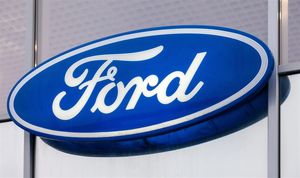
Tesla’s third quarter results drew a negative market reaction, reflecting investor concerns about profitability despite the company’s strong top-line growth and record vehicle deliveries. Management attributed performance to robust demand for the Model Y and ongoing expansion in robotaxi operations, with North America, China, and Europe all contributing to higher volumes. CFO Vaibhav Taneja emphasized that “the strength in deliveries was attributed to strong performance across all regions,” and highlighted improved material cost management and fixed cost absorption as factors supporting automotive margins, even as gross and operating margins declined year-over-year.
Is now the time to buy TSLA? Find out in our full research report (it’s free for active Edge members).
Tesla (TSLA) Q3 CY2025 Highlights:
- Vehicles Delivered: 497,099 vs analyst estimates of 471,057 (5.5% beat)
- Revenue: $28.1 billion vs analyst estimates of $26.59 billion (5.7% beat)
- Operating Profit (GAAP): $1.62 billion vs analyst estimates of $1.57 billion (3.6% beat)
- EPS (non-GAAP): $0.50 vs analyst expectations of $0.56 (10.5% miss)
- Automotive Revenue: $21.21 billion vs analyst estimates of $19.83 billion (6.9% beat)
- Energy Revenue: $3.42 billion vs analyst estimates of $3.44 billion (small miss)
- Services Revenue: $3.48 billion vs analyst estimates of $3.26 billion (6.7% beat)
- Gross Margin: 18%, down from 19.8% in the same quarter last year
- Operating Margin: 5.8%, down from 10.8% in the same quarter last year
- Market Capitalization: $1.53 trillion
While we enjoy listening to the management's commentary, our favorite part of earnings calls are the analyst questions. Those are unscripted and can often highlight topics that management teams would rather avoid or topics where the answer is complicated. Here is what has caught our attention.
Our Top 5 Analyst Questions From Tesla’s Q3 Earnings Call
-
Emmanuel Rosner (Wolfe Research) asked about production expansion timelines and whether volume growth would be prioritized over near-term profitability. CEO Elon Musk said production could approach three million units annualized within two years, but stressed, “I don’t think we’ll sacrifice margins,” citing strong demand for autonomous vehicles.
-
Dan Meir Levy (Barclays) questioned how Tesla defines its AI core competencies and the boundary between internal efforts and external opportunities. Musk replied that Tesla’s competencies are “created while you wait,” emphasizing the company’s history of developing new verticals from scratch and the scale potential of projects like Optimus.
-
Dan Meir Levy (Barclays) followed up on the relationship between Tesla’s AI initiatives and Musk’s separate xAI project. Musk distinguished Tesla’s real-world AI as focused on embedded intelligence for cars and robots, whereas xAI’s Grok targets general-purpose artificial intelligence at much larger computational scale.
-
Walt (LightShed Partners) inquired about regulatory and operational factors limiting safety driver removal in robotaxi markets. Musk said Tesla would use a phased approach, initially deploying safety drivers in new cities for several months to ensure safety before fully autonomous operations.
-
Colin Langan (Oppenheimer) asked about the timeline for Optimus robot production and the state of the supply chain for dexterous components. Musk indicated hardware design would continue to iterate post-production start, with a production-intent prototype expected in Q1 and initial ramp toward one million units per year by late next year.
Catalysts in Upcoming Quarters
Looking forward, our analysts will be watching (1) the pace of autonomous vehicle and robotaxi expansion into new cities, (2) regulatory approvals for unsupervised full self-driving in major global markets, and (3) the rollout and adoption of new AI-powered products, including the Cyber Cap and Optimus robot. The trajectory of R&D spending and ability to manage margin pressures will also be critical signposts.
Tesla currently trades at $459.60, up from $438.73 just before the earnings. In the wake of this quarter, is it a buy or sell? The answer lies in our full research report (it’s free for active Edge members).
High-Quality Stocks for All Market Conditions
Trump’s April 2025 tariff bombshell triggered a massive market selloff, but stocks have since staged an impressive recovery, leaving those who panic sold on the sidelines.
Take advantage of the rebound by checking out our Top 6 Stocks for this week. This is a curated list of our High Quality stocks that have generated a market-beating return of 183% over the last five years (as of March 31st 2025).
Stocks that made our list in 2020 include now familiar names such as Nvidia (+1,545% between March 2020 and March 2025) as well as under-the-radar businesses like the once-micro-cap company Tecnoglass (+1,754% five-year return). Find your next big winner with StockStory today.
StockStory is growing and hiring equity analyst and marketing roles. Are you a 0 to 1 builder passionate about the markets and AI? See the open roles here.







